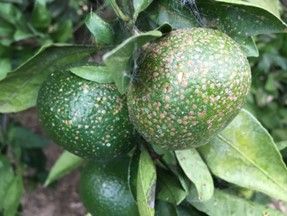The purpose of this factsheet is to give the general public and citrus growers basic knowledge regarding the California red scale.
Description and Life Cycle
Females are wingless, 0.06–0.08 inch in length, with a red-brown to red-grey roundish cover attached to the leaf. Females remain under this cover throughout their lives and produce 150–200 crawlers when mature.
Crawlers hatch and emerge in spring from under the female’s cover. Crawlers are the only mobile stage for females, and this is the stage that is the most susceptible to contact insecticides. Crawlers will settle on twigs, fruits, or leaves and start feeding. Soon after, the circular waxy cover forms over their bodies. Males will develop in the elongated cover and will emerge as a small, fragile, short-lived, two-winged insect. Females molt twice, creating a concentric ring in the center of the waxy covering each time. Once the female dies, the covering remains, which explains why scales might still be present even after an insecticide application.

Credit: UF/IFAS
Damage
California red scales are piercing-sucking insects that feed on aerial parts of the citrus tree including twigs, leaves, branches, and fruit. Damage to fruits is mainly cosmetic; however, if scale numbers are high, serious damage such as leaf yellowing and drop, and twig and limb dieback may occur. Severely infested trees may occasionally die. Tree damage is mostly apparent in late summer and early fall. California red scales are usually well controlled by natural enemies; therefore, broad-spectrum insecticides are not recommended.

Credit: UF/IFAS